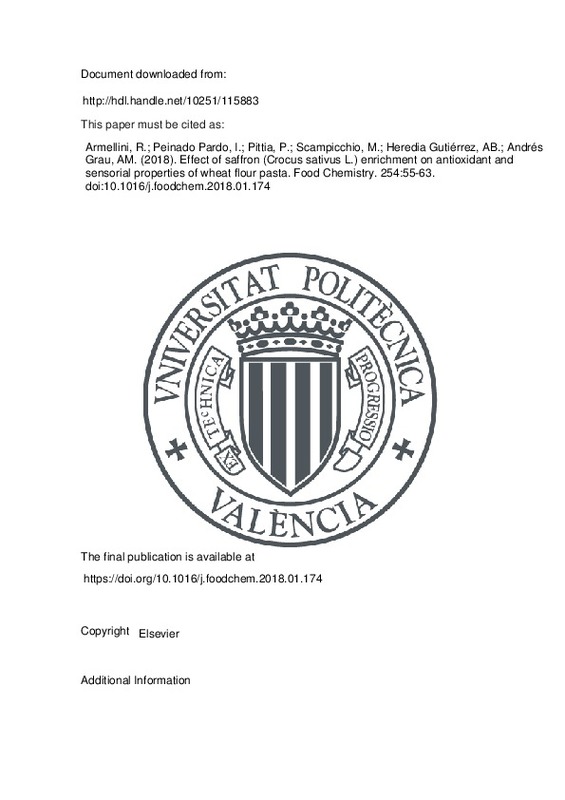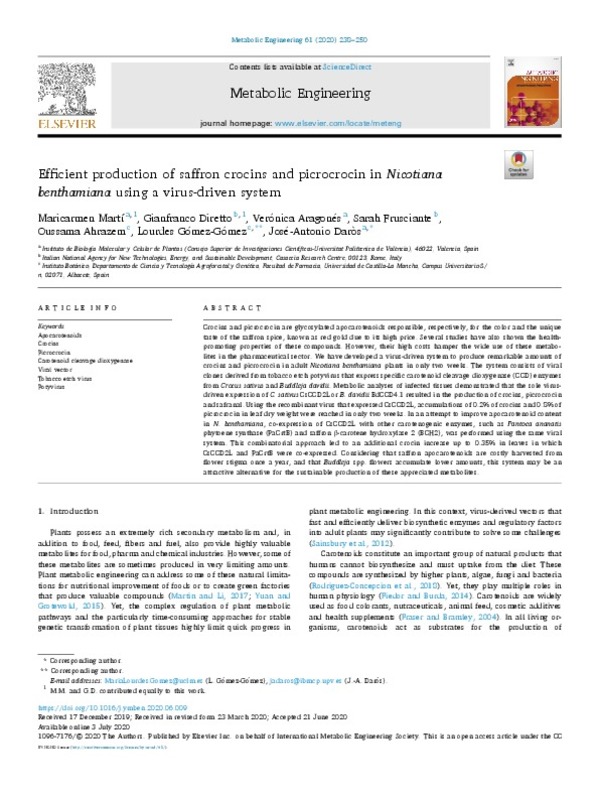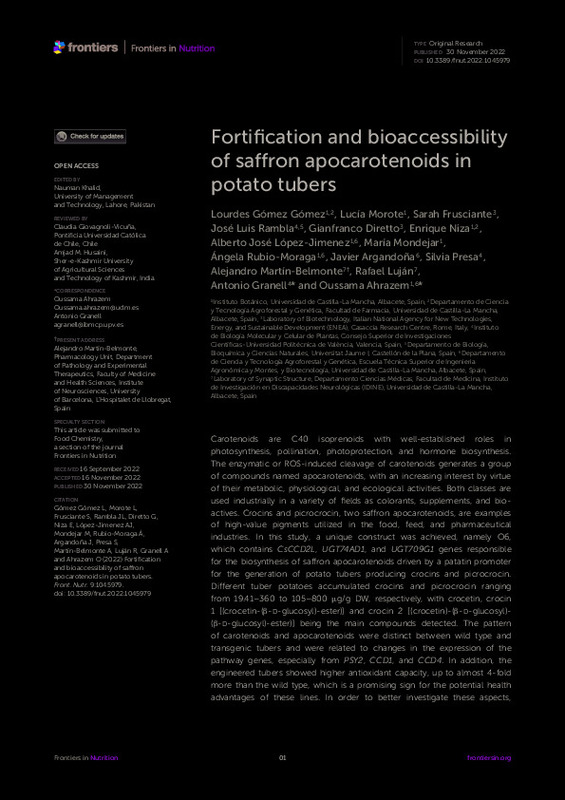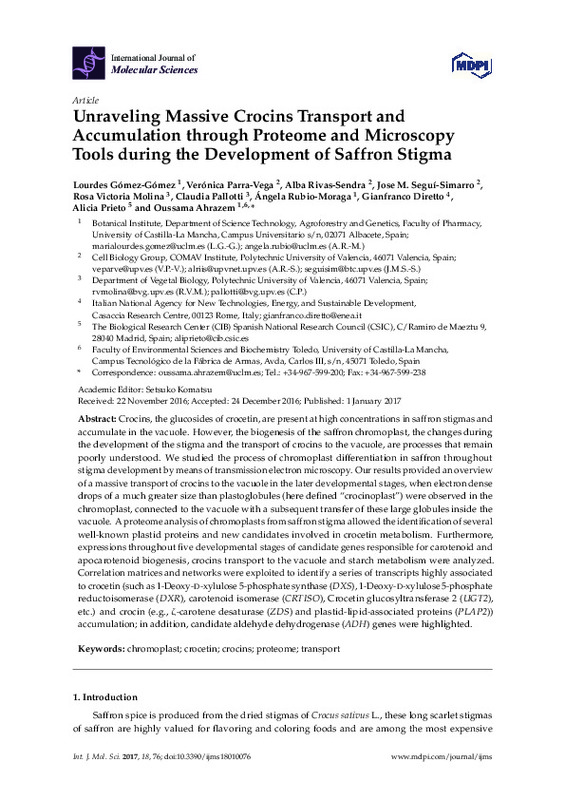

Listar por palabra clave "Crocins"
RiuNet: Repositorio Institucional de la Universidad Politécnica de Valencia
- RiuNet repositorio UPV
- :
- Listar por palabra clave
JavaScript is disabled for your browser. Some features of this site may not work without it.
Buscar en RiuNet
Listar
Mi cuenta
Ayuda RiuNet
Admin. UPV
Listar por palabra clave "Crocins"
Mostrando ítems 1-7 de 7
-
Stelluti, Stefania; Grasso, Gianluca; Nebauer, Sergio G.; Alonso, Gonzalo Luis; Renau-Morata, Begoña; Caser, Matteo; Demasi, Sonia; Lumini, Erica; Gómez-Gómez, Maria Lourdes; Molina, Rosa Victoria; Bianciotto, Valeria; Scariot, Valentina (Elsevier, 2024-01-01)[EN] Crocus sativus L. (saffron) has been propagated for millennia to produce the precious spice saffron from the red stigmas. The inebriant organoleptic and bioactive properties mainly depend on the content of crocins ...
-
Armellini, Rita; Peinado Pardo, Irene; Pittia, Paola; Scampicchio, M.; Heredia Gutiérrez, Ana Belén; Andrés Grau, Ana María (Elsevier, 2018)[EN] Saffron, used in cookery as a flavouring and colouring agent, is well-known for its antioxidant and beneficial health properties. In the present work, the effect of saffron addition (0-control, 0.1, 0.2 and 0.4%, w/w) ...
-
Martí, Maricarmen; Diretto, Gianfranco; Aragones, V; Frusciante, Sarah; Ahrazem, Oussama; Gómez-Gómez, Lourdes; Daròs, José-Antonio (Elsevier, 2020-09)[EN] Crocins and picrocrocin are glycosylated apocarotenoids responsible, respectively, for the color and the unique taste of the saffron spice, known as red gold due to its high price. Several studies have also shown the ...
-
Gómez Gómez, Lourdes; Morote, Lucía; Frusciante, Sarah; Rambla Nebot, Jose Luis; Diretto, Gianfranco; Niza, Enrique; López-Jiménez, Alberto José; Mondejar, María; Rubio-Moraga, Ángela; Ardangoña, Javier; Presa Castro, Silvia; Martin-Belmonte, Alejandro; Luján, Rafael; GRANELL RICHART, ANTONIO; Ahrazem, Oussama (Frontiers Media S.A., 2022-11-30)[EN] Carotenoids are C40 isoprenoids with well-established roles in photosynthesis, pollination, photoprotection, and hormone biosynthesis. The enzymatic or ROS-induced cleavage of carotenoids generates a group of compounds ...
-
Gómez-Gómez, Lourdes; López-Jimenez, Alberto Jose; Fajardo, Cristian Martinez; Morote, Lucia; Frusciante, Sarah; Rambla Nebot, Jose Luis; Diretto, Gianfranco; Rubio-Moraga, Angela; Mondejar-López, Maria; Niza, Enrique; Argandoña, Javier; Presa Castro, Silvia; Granell, Antonio; Ahrazem, Oussama (John Wiley & Sons, Inc., 2024-08)[EN] The stigmas of Crocus sativus accumulate the exclusive apocarotenoids crocin and picrocrocin, which are dried and desiccated to make commercial saffron. In addition to providing characteristic organoleptic qualities, ...
-
Demurtas, Olivia Costantina; Sulli, Maria; Ferrante, Paola; Mini, Paola; Aragones, V.; Daròs, José-Antonio; Marti, Maricarmen; Giuliano, Giovanni (MDPI AG, 2023-06)[EN] Crocins are glycosylated apocarotenoids with strong coloring power and anti-oxidant, anticancer, and neuro-protective properties. We previously dissected the saffron crocin biosynthesis pathway, and demonstrated that ...
-
Gómez Gómez, Lourdes; Parra Vega, Verónica; Rivas Sendra, Alba; Seguí Simarro, José María; Molina Romero, Rosa Victoria; Pallotti Sagripanti, Claudia Gabriela; Rubio Moraga, Ángela; Diretto, Gianfranco; Prieto, Alicia; Ahrazem, Oussama (MDPI, 2017-01-01)Crocins, the glucosides of crocetin, are present at high concentrations in saffron stigmas and accumulate in the vacuole. However, the biogenesis of the saffron chromoplast, the changes during the development of the stigma ...
Mostrando ítems 1-7 de 7

Universitat Politècnica de València. Unidad de Documentación Científica de la Biblioteca (+34) 96 387 70 85 · RiuNet@bib.upv.es









